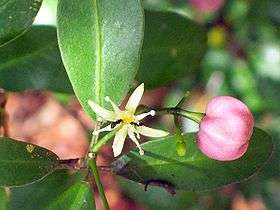Acronychia laevis
| Hard aspen | |
|---|---|
 | |
| Leaves, flower and fruit of the hard aspen | |
| Scientific classification | |
| Kingdom: | Plantae |
| (unranked): | Angiosperms |
| (unranked): | Eudicots |
| (unranked): | Rosids |
| Order: | Sapindales |
| Family: | Rutaceae |
| Genus: | Acronychia |
| Species: | A. laevis |
| Binomial name | |
| Acronychia laevis J.R.Forst. & G.Forst. | |
Acronychia laevis is a rainforest plant in the citrus family, growing in eastern Australia. The common name is the hard aspen. The habitat is dry rainforest, up to 700 metres above sea level. It grows from the upper Clarence River, New South Wales to Cape York Peninsula at the northernmost tip of Australia. It is also found on New Caledonia and Lord Howe Island.[1] The true aspens of the Northern Hemisphere belong to the genus Populus in the family Salicaceae.[2]
Taxonomy
Acronychia laevis was first described by German naturalists Johann Reinhold Forster and Georg Forster in 1775.[3] The specific epithet laevis is the Latin adjective "smooth", and refers to the new shoots and leaves.[4] It is a member of the Rutaceae family.[3]
Description
It grows as a bush or small tree up to 6 metres in height. It features attractive leaves, flowers, and pink fruit. The cylindrical trunk has fawn, fairly smooth bark. With some vertical lines and wrinkles. Small branches show leaf scars. Leaves are opposite on the stem, with only one leaflet. Leaf edges without serrations. Round, ovate, or obovate. Often blunt or rounded at the tip. 2.5 to 9.5 cm long, 1 to 5 cm wide.[5] Shiny on both sides. Oil dots may be seen under a lens with a bright light. The white or cream flowers appear on cymes from November to February. (Or as late as July). The fruit is a dark pink drupe, 6 to 8 mm wide.[4] Inside are reddish brown seeds, 4 mm long. Fruit matures from June to October. Germination is likely if the seeds are liberated from the pink fruit, then soaked.
Ecology
The fruit is eaten by the green catbird.[4]
Cultivation
Acronychia laevis can be grown in a sunny or part-shaded position in a garden. Its attractive fruit and flowers have horticultural appeal. It can be propagated from seed,[1] although cuttings may also be attempted. The fruit is edible to humans, although described as too pungent to be palatable,[6] and have even been likened to turpentine.[7]
References
- 1 2 Elliot, Rodger W.; Jones, David L.; Blake, Trevor (1985). Encyclopaedia of Australian Plants Suitable for Cultivation: Vol. 2. Port Melbourne: Lothian Press. p. 292. ISBN 0-85091-143-5.
- ↑ "technology transfer fact sheet: Populus spp." (PDF). Forest Products Laboratory: R&D USDA. Madison, Wisconsin: United States Department of Agriculture Forest Service. Retrieved 20 September 2010.
- 1 2 "Acronychia laevis J.R.Forst. & G.Forst.". Australian Plant Name Index (APNI), IBIS database. Centre for Plant Biodiversity Research, Australian Government.
- 1 2 3 Floyd, A.G., Rainforest Trees of Mainland South-eastern Australia, Inkata Press 2008, ISBN 978-0-9589436-7-3 page 345
- ↑ "Acronychia laevis". PlantNET - NSW Flora Online. Retrieved 2010-06-26.
- ↑ "Acronychia laevis (RUTACEAE); Glossy acronychia, hard aspen". Brisbane Rainforest Action & Information Network website. South Brisbane, Qld: Brisbane Rainforest Action & Information Network. 2007. Archived from the original on 15 February 2011. Retrieved 27 June 2010.
- ↑ Geo. W. Thorpe (2004). "The Rainforest: Yes, It may be Copied". Australian Plants online. Australian Native Plants Society (Australia). Retrieved 27 June 2010.